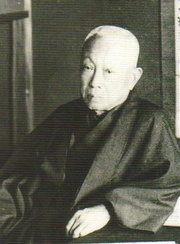Saionji Kinmochi
|
|
Saionji Kinmochi (西園寺 公望 Saionji Kinmochi October 23 1849–November 24 1940) was a Japanese politician and the 12th (January 7 1906–July 14 1908) and 14th (August 30 1911–December 21 1912) Prime Minister of Japan. As a statesman, he influenced the opinion of the Imperial Court.
He was born in Kyoto as the son of a Tokudaiji kuge, and was adopted by another kuge family, the Saionji. However, he grew up near his biological parents. Since the Tokudaiji and Saionji lived very near the Imperial Palace, the young Saionji was frequently ordered to visit the palace as a playmate of the young prince who was the future Emperor Meiji. Over time they became close friends. Kinmochi's biological brother Tokudaiji Sanetsune later became the Chief Chamberlain of the Emperor Meiji. Kinmochi's close relationship to the Imperial Court helped him in his political career. In his later political life, he was an influence on both the Taisho and Showa emperors.
As the heir of a noble family, Saionji participated in politics from an early age and was known for his brillant talent. During the Boshin War, which some noblemen at the Imperial Court considered to be a private dispute between samurai, Saionji held the strong opinion that the Imperial Court should seize the initiative and take part in the war. After the war, he was successively appointed to the governorship of Sanyo region, the governorship of Echigo Province and other offices. He went to France to research European culture and lived in Paris. While there, he gained many acquaintances, including Clemenceau.
In 1882, Ito Hirobumi visited Europe in order to research the constitutional systems of each European state. Saionji journeyed with Ito, as they knew each other very well. In 1890, Ito founded the Rikkenseiyukai political party and Saionji joined it. Reflecting on his experience in Europe, Saionji had a liberal political point of view and supported parliamentary government. He was one of the few politicians who claimed that the majority party in parliament had to be the basis for forming the cabinet. Nationalists accused him of being a globalist. In his last days, Saionji tried to diminish the influence of the Army in political issues but he couldn't prevent Japan from engaging in military adventures in China and other Asian countries.
On the other hand, Saionji's political philosophy was heavily influenced by his background; he believed the Imperial Court should be guarded and that it should not participate directly in politics - the same strategy employed by noblemen and the Court in Kyoto for hundreds of years. This was another point in which he was opposed by nationalists in the Army, who wished for the Emperor to participate in Japanese politics directly and thus weaken both parliament and the cabinet.
Saionji had a strong interst in education and founded some schools. He was influential in the formation of Kyoto University.
| Preceded by (first term): Katsura Taro | Prime Minister of Japan 1906–1908, 1911–1912 | Succeeded by (first term): Katsura Taro |
| Preceded by (second term): Katsura Taro | Succeeded by (second term): Yamamoto Gonnohyoe |

